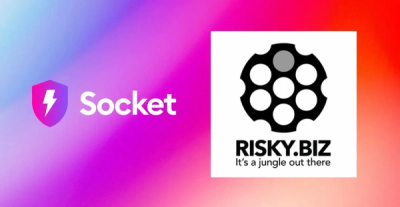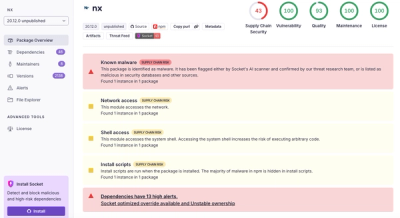
Security News
/Research
Wallet-Draining npm Package Impersonates Nodemailer to Hijack Crypto Transactions
Malicious npm package impersonates Nodemailer and drains wallets by hijacking crypto transactions across multiple blockchains.
cloud-run-render
Advanced tools
The build command at the root of the gcp package has two purposes
The rendering logic bundle is placed within this ./container folder, and the Dockerfile copies it over when creating the image.
The Dockerfile also bundles chromium and ffmpeg, and installs the functions-framework package in order to execute the Node code in a Cloud Run environment.
The Artifact Registry in GCP is a place to store container images. The Remotion-dev project has been created in GCP as a central place to host a public registry which can be read from by anyone. In particular, it is read from in the Remotion GCP API when deploying a new Cloud Run instance. The image that is retrieved is located at us-docker.pkg.dev/remotion-dev/cloud-run/render:${remotionVersion} where remotionVersion is a prop that gets passed in. Therefore, whenever a new version of Remotion is released, a new image needs to be added to the Artifact Registry that makes use of the latest Remotion Package. The images are tagged with the Remotion version, so that people can get the required version for their environment.
A Github Action Workflow has been created under the file deploy-gcp-artifact.yml. It authenticates with GCP using a service account in the remotion-dev project (github-action@remotion-dev.iam.gserviceaccount.com) using a workload identity pool. The service account has write permissions on the Artifact Registry repository that contains Cloud Run images. The workflow logs in to Artifact Registry, and uploads a new image, tagging it with the latest Release tag from GitHub, as well as tagging it with 'latest'. Subsequent images will take the 'lastest' tags for themselves, and only one image will have this tag at a time. This workflow will only run when a Release is published or edited in GitHub.
This pipeline should work as is, but the steps are recorded here for future troubleshooting if necessary.
Created a new service account, called github-action, whose purpose is to run the github action.
gcloud iam service-accounts create github-action \
--project remotion-dev
Enabled IAM API in the project
gcloud services enable iamcredentials.googleapis.com \
--project remotion-dev
Created a workload identity pool called github-id-pool
gcloud iam workload-identity-pools create github-id-pool \
--project=remotion-dev \
--location="global" \
--display-name=github-id-pool
Received a unique identifier for this pool
gcloud iam workload-identity-pools describe github-id-pool \
--project=remotion-dev \
--location="global" \
--format="value(name)"
Created a provider within the pool for github to access
gcloud iam workload-identity-pools providers create-oidc github-provider \
--project=remotion-dev \
--location="global" \
--workload-identity-pool=github-id-pool \
--display-name=github-provider \
--attribute-mapping="google.subject=assertion.sub,attribute.actor=assertion.actor,attribute.repository=assertion.repository" \
--issuer-uri="https://token.actions.githubusercontent.com"
Allow the GitHub Action based in the remotion repository to login to the service account via the provider.
gcloud iam service-accounts add-iam-policy-binding "github-action@remotion-dev.iam.gserviceaccount.com" \
--project=remotion-dev \
--role="roles/iam.workloadIdentityUser" \
--member="principalSet://iam.googleapis.com/projects/1079363441639/locations/global/workloadIdentityPools/github-id-pool/attribute.repository/remotion-dev/remotion"
Note for Jonny: For now I have also given access to my personal repo
This command returns the identifier of that provider
gcloud iam workload-identity-pools providers describe github-provider \
--project=remotion-dev \
--location="global" \
--workload-identity-pool=github-id-pool \
--format="value(name)"
Allow the newly created Service Account to access the Artifact Registry in the remotion-dev project
gcloud projects add-iam-policy-binding remotion-dev \
--member="serviceAccount:github-action@remotion-dev.iam.gserviceaccount.com" \
--role="roles/artifactregistry.writer"
Complete a build for the GCP package, so that cloudrun/container contains an up-to-date dist folder.
gcloud initgcloud config list should show that the correct account and project are active
d. if remotion-dev is not the current project, run gcloud config set project remotion-devcd into the packages/cloudrun/container folder.node submit.mjsFAQs
Render media and stills on GCP Cloud Run
The npm package cloud-run-render receives a total of 0 weekly downloads. As such, cloud-run-render popularity was classified as not popular.
We found that cloud-run-render demonstrated a not healthy version release cadence and project activity because the last version was released a year ago. It has 1 open source maintainer collaborating on the project.
Did you know?

Socket for GitHub automatically highlights issues in each pull request and monitors the health of all your open source dependencies. Discover the contents of your packages and block harmful activity before you install or update your dependencies.

Security News
/Research
Malicious npm package impersonates Nodemailer and drains wallets by hijacking crypto transactions across multiple blockchains.

Security News
This episode explores the hard problem of reachability analysis, from static analysis limits to handling dynamic languages and massive dependency trees.

Security News
/Research
Malicious Nx npm versions stole secrets and wallet info using AI CLI tools; Socket’s AI scanner detected the supply chain attack and flagged the malware.